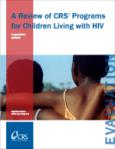
Media CenterThousands More Getting Life-Saving HIV Treatment from Local Organizations Across Africa
FOR IMMEDIATE RELEASE
CONTACT:
Kim Pozniak
Catholic Relief Services
[email protected]
410-951-7281
Report Shows that Faith-based Organizations in Four Countries
Continue the Legacy of U.S.-Government-funded AIDSRelief Program
BALTIMORE, MD, November 25, 2015 – A new report by Catholic Relief Services (CRS), to be released on World Aids Day, December 1, finds that local faith-based organizations in four African countries have increased the number of enrolled patients by up to 40 percent in the two years since they took over providing HIV care and treatment from the U.S. government-funded AIDSRelief program.
Funded by the President’s Emergency Plan for AIDS Relief (PEPFAR) and implemented by a consortium of international organizations led by CRS, AIDSRelief supported rapid scale-up of HIV care and treatment services for poor and underserved people in 10 countries across Africa, the Caribbean and Latin America between 2004 and 2013.
From its beginning, an essential part of the AIDSRelief program was transitioning care and treatment to local partners to ensure its sustainability. The report documents the success of that handover in Uganda, Kenya, Tanzania and South Africa as the increase in patients came with no decrease in the quality of care.
“When the first programs launched in 2004, many people did not believe it was possible to deliver high-quality, sustainable HIV treatment in low-resource settings,” said Michele Broemmelsiek, former Chief of Party of AIDSRelief. “Today, our partners on the ground are demonstrating the success of the AIDSRelief mission: strengthening local organizations so they can take ownership of and continue to provide sustainable HIV care and treatment to hundreds of thousands of people long after the program ended.”
By late 2014, local partners in six AIDSRelief countries had taken full responsibility for the program and were directly receiving U.S. government funding for HIV care and treatment. As the report notes, the transition to local partners needed to take place without compromising the quality of care or program managements.
“AIDSRelief had a ‘gold standard’ for health outcomes such as high viral suppression rates, low mortality and high patient retention, and our partners succeeded in maintaining these standards and the quality of care after the handover of the program,” Broemmelsiek said.
From the beginning, AIDSRelief worked with local faith-based health care providers to improve health systems’ operations and management, including better accounting practices, electronic patient databases, and hospital pharmacies. The program trained thousands of health workers to provide HIV treatment and services, to identify and manage treatment failure; diagnose, treat and prevent infections; and provide patients with adherence counseling and support, empowering them to effectively manage their own treatment, the report says.
“The success in Kenya, Uganda, Tanzania and South Africa is a huge step toward sustainable care and treatment of HIV in patients around the world, and a testament to the important role that faith-based organizations play in the fight against HIV,” Broemmelsiek said.
Between 2004 and 2013, AIDSRelief served more than 700,000 patients, including more than 390,000 who enrolled in antiretroviral therapy (ART) through 276 health facilities.
In Tanzania, Christian Social Services Commission (CSCC) took over the program in 2012. “[We were] really doubtful that the local partner could do what CRS was doing, but we don’t see any changes now that CSCC started. They are ready to help any time,” said Dr. Pius Masella, a District AIDS Control coordinator in Tanzania.
“The achievements of former AIDSRelief partners in the profiled countries are significant, considering that widespread treatment for HIV was barely imaginable when PEPFAR was launched in 2003,” Broemmelsiek said. “Today, local organizations are continuing AIDSRelief’s commitment to quality care and treatment, resulting in hundreds of thousands of patients who are thriving and families that remain intact.”
About AIDSRelief
AIDSRelief established basic packages of HIV care and treatment. Consortium partners included Catholic Relief Services; the University of Maryland School of Medicine Institute of Human Virology; Futures Group; IMA World Health and Catholic Medical Mission Board.
###
Catholic Relief Services is the official international humanitarian agency of the Catholic community in the United States. The agency alleviates suffering and provides assistance to people in need in more than 100 countries, without regard to race, religion or nationality. CRS’ relief and development work is accomplished through programs of emergency response, HIV, health, agriculture, education, microfinance and peacebuilding. For more information, please visit crs.org or crsespanol.org and follow CRS on social media: Facebook, @CatholicRelief, @CRSnews, YouTube, Instagram and Pinterest.




